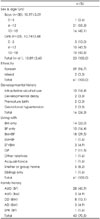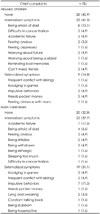Abstract
Objectives
Child abuse can affect mental and physical health of abused children. Accurate assessment of mental health of abused children is integral to providing proper treatment and preventing any further impact of childhood abuse on their future life. In this study, we investigated psychiatric illnesses among abused children.
Methods
Semi-structured interviews using the Kiddie-Schedule for Affective Disorders and Schizophrenia-Present and Lifetime Version-Korean Version were conducted for 61 abused children after obtaining consent from their guardians. We also assessed the relationship between the demographic data of these abused children and their diagnoses.
Results
Among the abused children, more than half had more than one psychiatric disorder. The most frequently diagnosed disorders were attention-deficit/hyperactivity disorder, posttraumatic stress disorder, depressive disorder, and oppositional defiant disorder. The incidence of posttraumatic stress disorder was higher in abused girls compared with abused boys. Abused children had a higher suicide risk than the general population. Among the parents of abused children, 50.8% had alcohol use disorders.
Figures and Tables
 | Fig. 1Family history of psychiatric disorders. AUD : Alcohol use disorder, DD : Depressive disorder, AD : Anxiety disorder, SPR : Schizophrenia. |
Table 5
Psychiatric diagnoses of the abused children

* : p<0.05. SAD : Separation anxiety disorder, HAD : Hyperanxiety disorder, GAD : Generalized anxiety disorder, OCD : Obsessive compulsive disorder, DD : Depressive disorder, PTSD : Posttraumatic stress disorder, ENU : Enuresis, ENC : Encopresis, ADHD : Attention deficit hyperactivity disorder, CD : Conduct disorder, ODD : Oppositional defiant disorder, CTD : Chronic tic disorder, TTD : Transient tic disorder
References
1. Kempe CH, Silverman FN, Steele BF, Droegemueller W, Silver HK. The battered-child syndrome. JAMA. 1962; 181:17–24.

2. Helfer RE, Pollock CB. The battered child syndrome. Adv Pediatr. 1968; 15:9–27.
3. Dube SR, Anda RF, Felitti VJ, Croft JB, Edwards VJ, Giles WH. Growing up with parental alcohol abuse: exposure to childhood abuse, neglect, and household dysfunction. Child Abuse Negl. 2001; 25:1627–1640.
4. Dube SR, Felitti VJ, Dong M, Chapman DP, Giles WH, Anda RF. Childhood abuse, neglect, and household dysfunction and the risk of illicit drug use: the adverse childhood experiences study. Pediatrics. 2003; 111:564–572.

5. Dube SR, Anda RF, Felitti VJ, Chapman DP, Williamson DF, Giles WH. Childhood abuse, household dysfunction, and the risk of attempted suicide throughout the life span: findings from the adverse childhood experiences study. JAMA. 2001; 286:3089–3096.

6. Ju S, Lee Y. Experiences of family maltreatment by Korean children in Korean national protective services. Child Abuse Negl. 2010; 34:18–27.

7. Lansford JE, Dodge KA, Pettit GS, Bates JE, Crozier J, Kaplow J. A 12-year prospective study of the long-term effects of early child physical maltreatment on psychological, behavioral, and academic problems in adolescence. Arch Pediatr Adolesc Med. 2002; 156:824–830.

8. De Bellis MD, Woolley DP, Hooper SR. Neuropsychological findings in pediatric maltreatment: relationship of PTSD, dissociative symptoms, and abuse/neglect indices to neurocognitive outcomes. Child Maltreat. 2013; 18:171–183.

9. Teicher MH, Samson JA. Childhood maltreatment and psychopathology: a case for ecophenotypic variants as clinically and neurobiologically distinct subtypes. Am J Psychiatry. 2013; 170:1114–1133.

10. Silverman AB, Reinherz HZ, Giaconia RM. The long-term sequelae of child and adolescent abuse: a longitudinal community study. Child Abuse Negl. 1996; 20:709–723.

11. Hadianfard H. Child abuse in group of children with attention deficithyperactivity disorder in comparison with normal children. Int J Community Based Nurs Midwifery. 2014; 2:77–84.
12. Mandell DS, Walrath CM, Manteuffel B, Sgro G, Pinto-Martin JA. The prevalence and correlates of abuse among children with autism served in comprehensive community-based mental health settings. Child Abuse Negl. 2005; 29:1359–1372.

13. Sullivan PM, Knutson JF. Maltreatment and disabilities: a population-based epidemiological study. Child Abuse Negl. 2000; 24:1257–1273.

14. Walsh C, MacMillan H, Jamieson E. The relationship between parental psychiatric disorder and child physical and sexual abuse: findings from the ontario health supplement. Child Abuse Negl. 2002; 26:11–22.

15. Kaufman J, Zigler E. The intergenerational transmission of child abuse. In : Cicchetti D, Carlson V, editors. Child maltreatment: theory and research on the causes and consequences of child abuse and neglect. Cambridge: Cambridge University Press;1989. p. 129–150.
16. Chang J, Rhee S, Weaver D. Characteristics of child abuse in immigrant Korean families and correlates of placement decisions. Child Abuse Negl. 2006; 30:881–891.

17. Feng JY, Jezewski MA, Hsu TW. The meaning of child abuse for nurses in Taiwan. J Transcult Nurs. 2005; 16:142–149.

18. Kim DH, Kim KI, Park YC, Zhang LD, Lu MK, Li D. Children's experience of violence in China and Korea: a transcultural study. Child Abuse Negl. 2000; 24:1163–1173.

19. Kaufman J, Birmaher B, Brent D, Rao U, Flynn C, Moreci P, et al. Schedule for affective disorders and schizophrenia for school-age children-present and lifetime version (K-SADS-PL): initial reliability and validity data. J Am Acad Child Adolesc Psychiatry. 1997; 36:980–988.

20. Kim YS, Cheon KA, Kim BN, Chang SA, Yoo HJ, Kim JW, et al. The reliability and validity of Kiddie-Schedule for affective disorders and schizophrenia-present and lifetime version-Korean version (K-SADS-PL-K). Yonsei Med J. 2004; 45:81–89.

21. van Ijzendoorn MH, Euser EM, Prinzie P, Juffer F, Bakermans-Kranenburg MJ. Elevated risk of child maltreatment in families with stepparents but not with adoptive parents. Child Maltreat. 2009; 14:369–375.

22. Afifi TO, MacMillan HL, Boyle M, Taillieu T, Cheung K, Sareen J. Child abuse and mental disorders in Canada. CMAJ. 2014; 186:E324–E332.

23. Walsh C, MacMillan HL, Jamieson E. The relationship between parental substance abuse and child maltreatment: findings from the ontario health supplement. Child Abuse Negl. 2003; 27:1409–1425.

24. Bierut LJ, Dinwiddie SH, Begleiter H, Crowe RR, Hesselbrock V, Nurnberger JI Jr, et al. Familial transmission of substance dependence: alcohol, marijuana, cocaine, and habitual smoking: a report from the collaborative study on the genetics of alcoholism. Arch Gen Psychiatry. 1998; 55:982–988.

25. Livingston J, Lyall H. Contribution of fetal alcohol syndrome to mental retardation. Lancet. 1986; 2:1337–1338.

26. Abel EL, Sokol RJ. Fetal alcohol syndrome is now leading cause of mental retardation. Lancet. 1986; 2:1222.

27. Ahn JJ, Kang SK, Kim HR, Yoo JA, Lee BJ, Lee EJ, et al. Investigation of child abuse in Korea. Seoul: Ministry of Health and Welfare;2011.
28. Teicher MH, Samson JA, Polcari A, McGreenery CE. Sticks, stones, and hurtful words: relative effects of various forms of childhood maltreatment. Am J Psychiatry. 2006; 163:993–1000.

29. Choi J, Jeong B, Rohan ML, Polcari AM, Teicher MH. Preliminary evidence for white matter tract abnormalities in young adults exposed to parental verbal abuse. Biol Psychiatry. 2009; 65:227–234.

30. Briscoe-Smith AM, Hinshaw SP. Linkages between child abuse and attention-deficit/hyperactivity disorder in girls: behavioral and social correlates. Child Abuse Negl. 2006; 30:1239–1255.

31. Fuller-Thomson E, Lewis DA. The relationship between early adversities and attention-deficit/hyperactivity disorder. Child Abuse Negl. 2015; 47:94–101.

32. Cornellà Canals J, Juárez López JR. [Attention-deficit hyperactivity disorder symptoms and their relationship with child abuse: predictor and consequence]. An Pediatr (Barc). 2014; 81:398.e1–398.e5.
33. Jonson-Reid M, Kohl PL, Drake B. Child and adult outcomes of chronic child maltreatment. Pediatrics. 2012; 129:839–845.

34. Taussig HN, Harpin SB, Maguire SA. Suicidality among preadolescent maltreated children in foster care. Child Maltreat. 2014; 19:17–26.

35. Rogers R. Nurse administered structured clinical interviews improve psychiatric diagnosis and treatment in community settings. Evid Based Ment Health. 2003; 6:109.

36. Robins LN, Wing J, Wittchen HU, Helzer JE, Babor TF, Burke J, et al. The composite international diagnostic interview. An epidemiologic instrument suitable for use in conjunction with different diagnostic systems and in different cultures. Arch Gen Psychiatry. 1988; 45:1069–1077.




 PDF
PDF ePub
ePub Citation
Citation Print
Print






 XML Download
XML Download